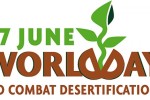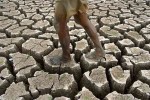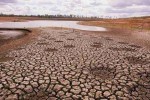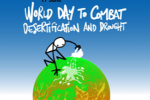2017 (EN)
17 June 2017
Tutte le Attività (EN) -
Anno 2017

In order to raise awareness among governments, organizations and individuals about the collective responsibility for sustainable use of water and to prevent desertification and drought, the Museum of Peace - MAMT has dedicated a thematic day to the theme: videos, meetings and an awareness campaign directed especially at young people.
In 1995, the United Nations General Assembly in Resolution A/RES/49/115 chose 17 June to celebrate World Day against Desertification and Drought. On the same day, in 1994, the United Nations Convention to Combat Desertification (UNCCD) was adopted in Paris, ratified by 200 countries. The objective of the Convention is to mitigate the effects of drought through international cooperation activities and partnership agreements in the countries most affected, particularly in Africa. The strategies implemented focus on improving soil productivity and sustainable management of land and water resources. According to a UNCCD study, we lose 24Â billion tonnes of fertile land every year and 15Â billion trees every hour, and 1.5Â billion people are being fed by land that is at risk of desertification. The practices considered unsustainable are monocultures, the use of chemicals and overgrazing.
The theme chosen this year for the Day is "Inclusive cooperation for achieving Land Degradation Neutrality". Achieving neutrality in terms of soil degradation means being able to ensure that losses of fertile soil are offset by improvements in other degraded areas. The slogan for 2016 is "Protecting the Earth. Restoring soils. Involve people. In his annual message on the occasion of the Day, Secretary General Ban -Ki Moon said that desertification, drought and climate change are interlinked phenomena and for this reason, collective cooperation is needed that includes all actors involved in order to achieve neutrality in terms of soil degradation, an objective set out in point 15.3 of the 17 Sustainable Development Goals.
On 17 June the official celebrations took place in Beijing and the MAMT Museum disconnected itself from this city.
This is particularly important because, although China is one of the countries most affected by desertification and one of the countries most responsible for global pollution, in 2013 it embarked on a new development strategy. Since then, it has promoted the construction of sustainable low-carbon infrastructure, in cooperation with neighbouring countries. This cooperation resulted in the initiative "One Belt and One Road Joint Action to Combating Desertification Initiative", details of which will be presented during the event in Beijing.
Various initiatives are planned around the world on the occasion of the Day. Also in Italy, in addition to the event at the MAMT Museum, there were several events linked to the celebration of this day. In particular, in Sassari the celebrations will be curated by the festival "Pensieri e Parole: libri e film all' Asinara", by the Conservatory "Canepa", by the Koinè Bookshop and by the Desertification Research Unit of the University of Sassari. In addition, the Research Centre of Sassari organised a two-day conference at the end of the Wadis-Mar Project, a project financed by the European Commission for the implementation of techniques for collecting and recharging groundwater in the two basins of Oued Biskra in Algeria and Oum Zessar in Tunisia.
Italy ratified its accession to the UNCCD in 1997, both as a donor country and as a country affected by desertification. The National Committee for Combating Drought and Desertification (CNLSD) was set up in 1997 by the Ministry of the Environment to coordinate the implementation of the Convention in Italy. In 1999, the Interministerial Committee for Economic Programming (CIPE) adopted the National Action Programme to Combat Drought and Desertification, which identifies the strategies to be implemented both at state and regional level to combat desertification and drought in Italy. In particular, the programme covers four areas: soil protection, sustainable management of water resources, reducing the impact of production activities and rebalancing the territory.
According to Legambiente, the regions that are heavily at risk are Basilicata, Calabria, Campania, Molise, Apulia, Sardinia and Sicily. The situation is particularly serious in Sardinia, where the danger of desertification affects as much as 52% of the regional territory, of which 11% has already been affected.
THE DROUGHT IN ITALY
One fifth of Italian territory is considered to be at risk of desertification. The warning of specialists is relaunched by the WWF: these are areas belonging to regions of southern Italy, such as Molise, Campania, Basilicata, Apulia, Sardinia and Sicily, but are also involved in other regions such as Emilia-Romagna, Marche, Umbria and Abruzzo. According to the scenarios of climate change scenarios developed by specialists for our country (in particular the Euro-Mediterranean Centre for Climate Change), by the end of the century, forecasts could foresee increases in temperatures between 3 and 6 °C with the consequent extremisation of meteoric phenomena and therefore also reductions in different areas of rainfall, especially in summer periods and it is clear that the climatic problems and those related to desertification will be increasingly intertwined. In our country, an unprecedented rise in temperature is already taking place, with an unprecedented fall in annual rainfall, with drier summers and more humid winters, particularly in the northern regions. In a complex and fragile territory such as Italy, these phenomena lead to a substantial change in the frequency and extent of landslides, floods and low river flows, with important effects for spatial planning and water systems. According to the most recent data available in Italy, we have a quantity of renewable water resources corresponding to about 116 billion cubic meters, while the volumes of water actually usable are estimated to be around 52 billion cubic meters. Overall, we use more than 30% of the renewable water resources available in our country, which are well above the 20% threshold indicated by the European objective (Europe efficient in the use of resources): for this reason, Italy is indicated by Ocse as a country subject to medium-high water stress which, moreover, presents a great lack of homogeneity with respect to the distribution of water resources and their needs. According to ISTAT data on the different types of use of water resources, drinking water abstraction is increasing (by 6.6% compared to the beginning of the 13 year old series) and amounts to 9.5 billion cubic metres (average daily consumption per inhabitant reaches 228 litres). Drought is also affecting the Oasis and for some time now: water levels in wetlands are falling and there are already dry areas. The aquifers have lowered in several places. Vegetation in some areas managed by the WWF is already in advanced water stress. However, conditions are being monitored to prevent fire or damage to the fauna. Some examples: Nature Reserve of Ripa Bianca (Marche); Nature Reserve of Valle Averto (Veneto); Oasis of Macchiagrande (Lazio) and the Nature Reserve of Orti-Bottagone (Tuscany). See more at:









